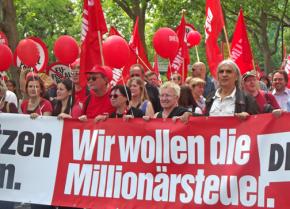“Blockupying” Frankfurt
reports from Germany on a series of demonstrations that highlighted the government's central role in pushing austerity across Europe.
WHILE MOST of the world had its eyes on Chicago last weekend for the NATO summit and ensuing protests, Europe was witnessing its own weekend of spectacular protests against economic austerity and corporate power.
More than 30,000 demonstrators gathered in Frankfurt, Germany, for three days of protest under the slogan "Blockupy Frankfurt!"--with the goal of blockading the European Central Bank and sending a message that the people of Germany stand with the people of Greece and southern Europe against austerity and economic blackmail.
The demonstrations were a success despite shockingly high levels of police repression in the run-up to the events. The organizers of Blockupy had originally planned for three days of creative protest and public assemblies, set to culminate in a mass demonstration on Saturday, May 19. Groups ranging from Germany's radical left to the French anti-globalization network Attac had planned to erect large tents in Frankfurt's city center to hold public events and offer organizing space for activists.

Instead, the Frankfurt city government tried to outlaw the movement. It issued a general ban on public assemblies in the city for the entire week and threatened to ban the mass demonstration as well should protesters disobey.
Buses full of protesters were stopped on the highway outside of Frankfurt and searched for up to five hours to delay their arrival in the city. Several were even ordered to turn around and drive home. Up to 6,000 on-duty police officers ensured that most attempts to protest on Thursday and Friday were met with police violence and mass arrests.
But the police's strategy backfired. Unprecedented levels of repression ensured that public sympathy was with the movement and not the police. Although the police managed to stop protesters from blockading Frankfurt's financial district, by the time the demonstration was to begin on Saturday, images of police violence and a city occupied by riot cops encouraged thousands of locals and sympathizers to join the march.
The march took on multiple political meanings, as many participants voiced their desire to stand up for freedom of speech and assembly, raising questions about the compatibility of capitalism and democracy. Anchored by the Left Party, autonomist groups and large international delegations from Italy and France, the colorful demonstration of more than 30,000 people marked the first major anti-capitalist event in Germany since 2009, and will set a strong precedent for bigger mobilizations in the coming months.
ALTHOUGH THE demonstration was a big success, it also highlighted many of the weaknesses confronting the German left. Most dramatic was the large gap between Saturday's huge demonstration and the relatively small numbers--roughly 2,000--who participated in the more radical actions earlier in the week.
Blockupy organizers, largely from the autonomist groups, had speculated that 30,000 to 40,000 protesters would show up to blockade the European Central Bank. They focused most of their energy on tactical questions: how to break through police lines, how to hold occupied spaces against police invasion, etc. However, little focus was paid to the political work of mobilizing an anti-capitalist movement that has been largely dormant in Germany since 2009.
Many of the posters and fliers produced to advertise the march employed abstract imagery and obtuse language that was often not understood by the average reader. This meant that come Friday, May 18, quixotic scenes of small handfuls of protesters futilely trying to confront riot police battalions were quite common.
Indeed, had it not been for the thousands of police harassing and chasing the small numbers of protesters present, the press could have taken to ridiculing the movement for dramatically overestimating its own strength, rather than criticizing the police brutality and thereby building support for the demonstration like they did.
Also missing from the demonstration was most of the labor movement. Only one trade union participated in the march. Although the Confederation of German Trade Unions allowed protesters to use their Frankfurt headquarters as an organizing space, they did not participate in the demonstration themselves. This is unfortunate, as the German trade unions, despite recent setbacks, is still the largest and strongest in Europe. Had the unions pulled their massive weight, they could easily have doubled or even tripled the size of the demonstration through their participation.
Despite these weaknesses, Blockupy Frankfurt was an important step forward for a German left that has been unable to mobilize large numbers against austerity for the last few years. Given Germany's position as the paymaster of Europe and its role in driving the Greece economy into the ground, it is absolutely vital that a strong movement against austerity and for solidarity with Greece develop here.
The demonstration sent a signal that Germany's left is part of a united movement in Europe opposed to the austerity measures of the European Union and the International Monetary Fund, and hopefully will mark the beginning of a much larger push for an alternative vision for the continent. No doubt the trade union leadership took notice of what happened May 19, and will perhaps be more receptive to similar actions in the future.
Frankfurt was also a success for Germany's Left Party, which has been wrought with internal conflict amid bitter electoral defeats in the last two years. The Left's bloc at the demonstration was loud and colorful, and clearly demonstrated that the Left Party is a party of and for the movement. Many prominent party members spoke and were received warmly by the crowd.
The demonstration comes at a crucial juncture for the party. Its members come together next month to elect a new leadership, and a showdown between the right and left wings of the party seems increasingly likely to occur. The experience of Frankfurt showed that the party can still play an important role in building resistance from below and bringing together different movements in unified actions, if it so chooses.


